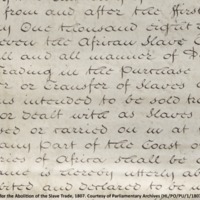
The Case for Immediate Not Gradual Abolition of Slavery
In the 1820s, the campaigner Elizabeth Heyrick became actively involved in door-to-door visits in Leicester in support of the anti-slavery cause and sugar boycotts. Her pamphlet ‘Immediate not gradual Abolition’ went into three editions during the first year of its publication in 1824. This exhibition focused on the life and work of Heyrick and in particular her efforts to abolish slavery. A Family Learning Day included ‘Elizabeth Heyrick’ in costume reading her pamphlet, storytelling, gospel music and an opportunity to sample food that would have been eaten by the enslaved.
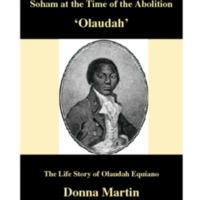
Soham at the Time of the Abolition
Soham Village College partnered with Soham Action 4 Youth (SA4Y) and Soham Museum in a project to record Soham at the Time of the Abolition, to commemorate the bicentenary and celebrate the life of Olaudah Equiano. Equiano, otherwise known as Gustavus Vassa, was the former slave who became an antislavery campaigner in the 18th century. His connection to the Cambridgeshire town of Soham is in his marriage to a local woman, Susannah Cullen, at St Andrew’s Church. Both of his daughters were born and baptised in the town. The research aspect of the project including mapping the town of Soham as it was in the 18th century, the results of which were published in a book by Mac Dowdy. 'Olaudah: The Life Story of Olaudah Equiano' was written by Donna Martin.
Several community events took place during the course of 2007 and 2008, including a re-enactment of Equiano’s wedding at St Andrew's Church in Soham, performed by Soham Village College theatre group Stage Chance, in partnership with Momentum Art’s Untold Stories Arts and Heritage Project. The event also comprised several speakers and performances of African dance and drumming, and the launch of a book by Angelina Osborne about the life of Joanna Vassa, Equiano’s only surviving daughter. A permanent plaque to Olaudah Equiano was unveiled in the church. The project also featured an exhibition of African art and portraits of Equiano by Soham residents and young people.
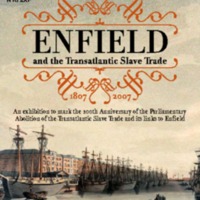
Enfield and the Transatlantic Slave Trade
An exhibition to mark the bicentenary was developed by Enfield Museum Service in partnership with the British Museum and Enfield Racial Equality Council. The exhibition looked at West African culture, the development of the local African community, the links between the transatlantic slave trade and Enfield, wealthy landowners and Quaker abolitionists who lived in the area. Free family days held during school vacations offered traditional Ghanaian story-telling, dancing and drumming, crafts and object handling. Living History Days gave visitors the opportunity to meet actors portraying William Wilberforce and Olaudah Equiano. School workshops included a drama session and performance about a runaway slave developed from material from Lambeth Archive. The museum service also produced a book, edited by Valerie Munday, which explored further the links between Enfield and the slave trade. The book was sent to all schools in the borough, and formed the basis of a teaching resource aimed at Key Stages 2 and 3. Loan boxes and handling collections provided by the museum service include Ghanaian artefacts and items relating to the slave trade. In 2011, Enfield Racial Equality Council unveiled a plaque to commemorate abolition at the Enfield Civic Centre.
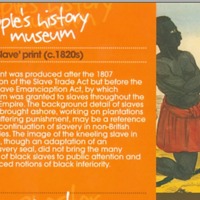
Revealing Histories: Remembering Slavery (People's History Museum)
Events at the People's History Museum in Manchester included a Revealing Histories trail, which highlighted museum objects with links to slavery, such as 'The Slave' print from the 1820s. A living history performance, 'How do you plead?', featured a representation of the Chartist leader William Cuffay, whose campaign for the right to vote saw him transported to Tasmania for treason.
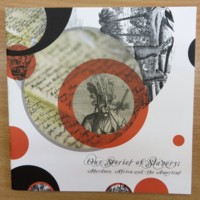
Our Stories of Slavery: Aberdeen, Africa and the Americas
The Our Stories of Slavery events programme ran from May to October 2007, co-ordinated by the Arts Development team at Aberdeen City Council. The project examined all aspects of Aberdeen's links with slavery and the transatlantic slave trade, including the role of Aberdonian landowners as slave owners, as well as the impact of Aberdonians as abolitionists, such as the roles played by James Beattie and James Ramsay.
One focus of the project was on the role of Aberdonian magistrates in kidnapping children from the City and Shire and selling them into indentured service to plantation owners during the 18th century. Peter Williamson, known as 'Indian Peter', was one of up to 700 kidnapped in Aberdeen between 1735 and 1750. The project used his story, with archives at the University of Aberdeen, in a range of activities including storytelling, re-enactments, film making, workshops, creative writing and craft workshops. Kidnapped was a re-enactment set in and around The Tolbooth (Aberdeen's Museum of Civic History). In collaboration with artist Chris Biddlecombe, community knitting circles created 'Cast-offs', exhibited at Aberdeen's Kirk of St Nicholas, whereby an installation of 600 knitted jumpers represented the abducted children.
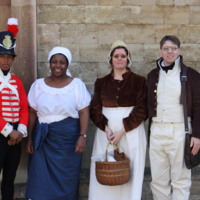
Beyond the Bicentennial
In collaboration with the Peterborough branch of the African Caribbean Forum, Peterborough Museum hosted 'Beyond the Bicentennial, 1788-1838: Exploring 50 Years of the Slave Trade'. The exhibition's focus was the fifty years leading up to the end of slavery in the British Empire, 1833. It highlighted museum objects and local connections to the era of abolition, including black communities in Peterborough and links between slave-produced sugar and the rise of tea drinking in Georgian Britain. Two special event days included Georgian period re-enactors, historical talks on slavery, African drumming workshops, African food tasting and community displays.
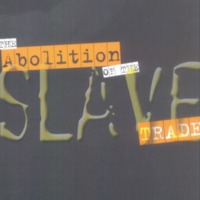
The Abolition of the Slave Trade
Kirklees Council ran a range of events in 2007, focused on local connections with slavery and abolition. Kirklees Civic Sunday was the official commemoration at Huddersfield Parish Church, with a performance by a local gospel choir and a presentation by actors as historical characters. The links between Yorkshire and the Caribbean were also explored: 8,500 people of African-Caribbean descent live in the borough of Kirklees. Events such as the Jamaica National Independence Cultural Festival, Deighton Carnival and Huddersfield Carnival celebrated African and Caribbean culture. Part of the Kirklees programme was to host the Equiano Project's touring exhibition at the Hudawi Centre in Huddersfield. The Centre went on to name one of its rooms after Equiano. Other events included talks from historians, including Richard Reddie and Paul Crooke, church services, choir concerts and theatre productions.
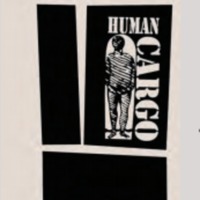
Human Cargo: The Transatlantic Slave Trade, its Abolition and Contemporary Legacies in Plymouth and Devon
Human Cargo was a partnership project between Plymouth City Museum and Art Gallery, and the Royal Albert Memorial Museum, Exeter. The project consisted of two main components. The first was a historical exhibition, which explored the development of the transatlantic slave trade and, in particular, the role of Plymouth as a port, the involvement of the City's dignitaries and the South West's links with the abolition movement. The second part was a contemporary art response to modern forms of slavery and historical legacies, including the flower picking trade, sweatshop labour and the Fair Trade Movement. This work was newly commissioned and included audio visual pieces, installations, hand-printed wallpaper and participatory objects. A variety of events and activities took place alongside the exhibition including education workshops, performances, African music and storytelling activities, and Elizabethan House re-enactment sessions.